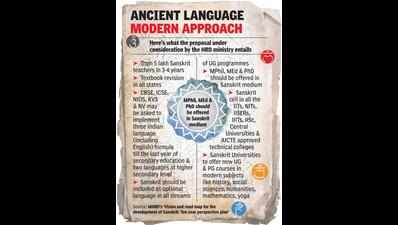- News
- City News
- delhi News
- From primary to PhD, a big Sanskrit push
Trending
This story is from April 13, 2017
From primary to PhD, a big Sanskrit push

A road map has been suggested by a 12-member committee headed by N Gopalaswami, chancellor of Rashtriya Sanskrit Vidyapeeth, Tirupati.

At present, Sanskrit is taught from Class I to Class XII as one of the optional languages. Most state secondary education boards also offer Sanskrit as part of the three-language formula from Classes VI to X and as a second optional language in Classes XI and XII. There are around 5,000 traditional Sanskrit pathshalas and 1,000 Veda pathshalas. Around 120 universities offer Sanskrit at the undergraduate and postgraduate levels. In addition, there are 15 Sanskrit universities and around 1,000 traditional Sanskrit colleges. The number of those who study Sanskrit at a higher education level is estimated at around 10 lakh.
A master plan is to be created to train five lakh Sanskrit teachers under the Madhyamik Shiksha Abhiyan and Sarva Shiksha Abhiyan. Also, Sanskrit material on ‘Indian knowledge’ may be incorporated into school subjects such as science, mathematics and history. In addition, there is a proposal to implement the three-language formula at the secondary level in the courses offered by CBSE, ICSE, NIOS, Kendriya Vidyalaya Sangathan and Navodaya Vidyalayas.
In order to create qualified Sanskrit primary teachers, the plan is for National Council for Teacher Education to instruct educational institutions to offer Sanskrit Methodology as one of the papers in degree courses in education. The National Institute of Open Schooling will similarly offer courses in Sanskrit medium for its secondary education as it does in English, Hindi and Urdu.
In higher education, apart from making Sanskrit an optional language in the undergraduate programmes, the plan also envisages Sanskrit as a credit course in technical education offered under the All India Council for Technical Education. The roadmap envisions research work including theses written in Sanskrit for universities, while Sanskrit universities will offer subjects like history, social sciences, humanities, mathematics, yoga, as well as science and commerce subjects in the ancient language.
At the traditional school level, the objective is to create model Sanskrit-medium schools in every state to impart modern education along with traditional education in the language. At college level, all Sanskrit students and teachers would mandatorily need to have computer education. The HRD ministry will establish the National Centre for Sanskrit Teacher Training for in-service and short-term programmes.
End of Article
FOLLOW US ON SOCIAL MEDIA










